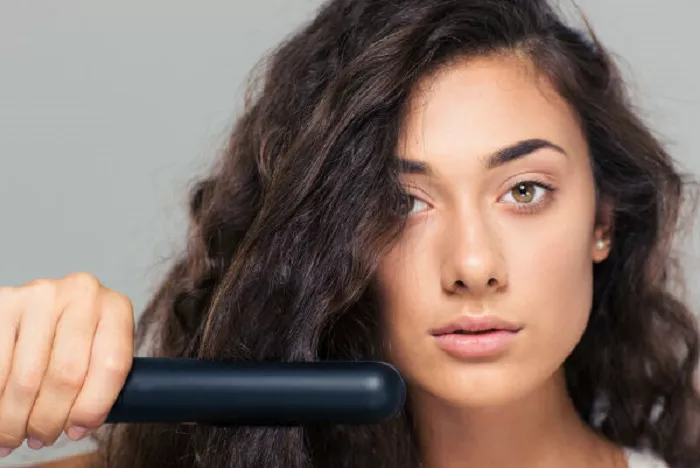Curly hair can be beautiful and unique, but there are times when you might want to straighten it for a change. However, the straightening process can often cause damage to the hair if not done properly. This article will provide you with comprehensive tips and techniques to straighten your curly hair while minimizing damage.
Preparation is Key
Choose the Right Tools
High – Quality Straightener: Invest in a good quality flat iron with adjustable heat settings. Ceramic or tourmaline – coated straighteners are preferable as they distribute heat more evenly and reduce the risk of hot spots that can burn the hair. Look for a straightener with a temperature range that allows you to set it according to your hair type. For curly hair, a lower heat setting (around 300 – 350°F or 150 – 175°C) is usually sufficient to avoid over – drying and damage.
Heat Protectant Spray: This is an essential product. Spray it evenly throughout your dry hair before using the straightener.
The heat protectant forms a protective barrier on the hair shaft, reducing the amount of heat that penetrates the hair and minimizing damage. Make sure to choose a heat protectant that is suitable for your hair type, whether it’s for dry, damaged, or normal hair.
Wash and Condition Your Hair Properly
Use a Gentle Shampoo: Avoid shampoos with harsh sulfates as they can strip the hair of its natural oils. Opt for a sulfate – free shampoo that will clean your hair without causing excessive dryness. When washing, be gentle and massage the scalp rather than vigorously scrubbing the hair.
Deep Condition Regularly: Curly hair tends to be drier, so deep conditioning at least once a week is beneficial. Use a rich, moisturizing conditioner and leave it on for the recommended time. You can also use a hair mask once a month for extra hydration. After conditioning, rinse your hair thoroughly with lukewarm water. Avoid hot water as it can open the hair cuticle too much, making the hair more prone to damage during the straightening process.
The Straightening Process
Section Your Hair
Divide your hair into small, manageable sections. This ensures that each strand of hair gets equal heat exposure. You can use clips to hold the sections you’re not working on. Start from the bottom layers and work your way up to the top. Smaller sections, about 1 – 2 inches wide, are ideal. This way, you can straighten each section more effectively and avoid having to pass the straightener over the same area multiple times, which can cause overheating and damage.
Straighten with Care
Set the Right Temperature: As mentioned earlier, start with a lower heat setting and adjust if necessary. If your hair is thick and coarse, you may be able to increase the temperature slightly, but always be cautious. Test the straightener on a small, hidden strand of hair first to see how it reacts.
Use the Right Technique: Place the straightener close to the roots of the hair section (but not too close to avoid burning the scalp) and slowly glide it down the length of the hair in one smooth motion. Do not clamp the straightener too tightly as this can cause creases in the hair. For very curly hair, you may need to make a second pass, but again, be careful not to overdo it. Avoid going back and forth with the straightener as this can cause friction and breakage.
Take Breaks
Do not straighten your entire head of hair in one go. Give your hair and the straightener a break every few sections. This allows the hair to cool down and reduces the cumulative heat damage. You can also use this time to check the straightened sections for any signs of damage or unevenness.
Post – Straightening Care
Apply a Finishing Product
Serum or Oil: After straightening, apply a small amount of hair serum or oil to add shine and further protect the hair. This helps to seal the cuticle and prevent moisture loss. Use a product that is lightweight and non – greasy, such as argan oil or a silicone – based serum. Apply the product evenly from the mid – lengths to the ends of the hair, avoiding the roots to prevent the hair from looking greasy.
Avoid Over – Styling
Try to limit the use of additional heat – styling tools after straightening. If you must use them, make sure to use another heat protectant. Also, avoid tight hairstyles like ponytails or braids that can put stress on the straightened hair and cause breakage. Let your hair breathe and stay as natural as possible.
Keep Your Hair Hydrated
Drink plenty of water to keep your body and hair hydrated from the inside. On the outside, you can use a leave – in conditioner or a light – weight moisturizing spray throughout the day if your hair starts to feel dry. This will help maintain the health of your straightened curly hair and prevent it from becoming brittle.
Conclusion
Straightening curly hair doesn’t have to mean sacrificing its health. By following these steps, from proper preparation with the right tools and hair care products, to a careful straightening process, and post – straightening maintenance, you can achieve a sleek, straight look without causing excessive damage. Remember, healthy hair is beautiful hair, and taking the time to care for your curls during the straightening process will ensure that they remain in good condition even after a style change.

